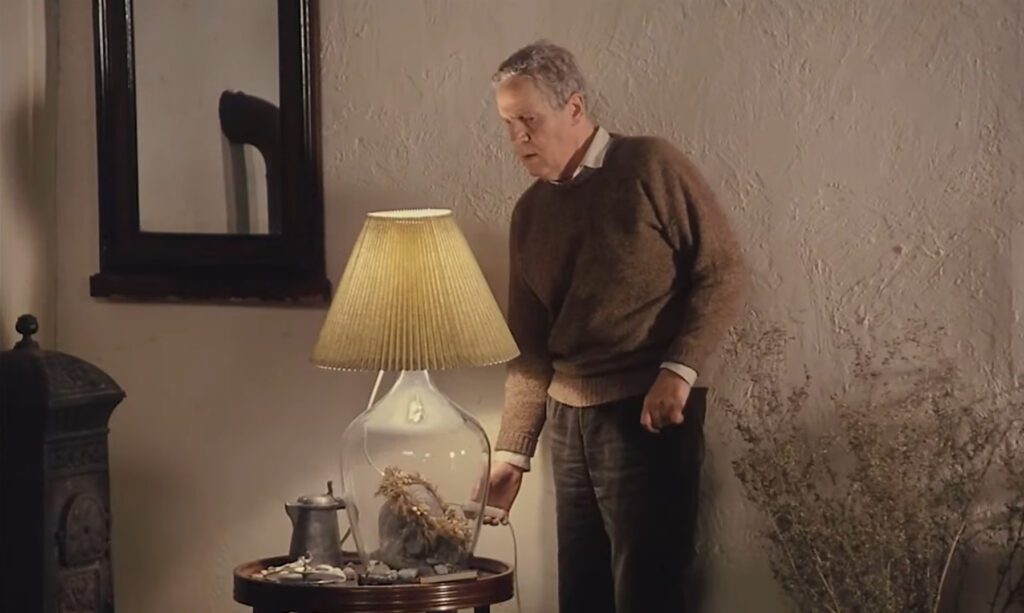
The Sacrifice
1986, directed by Andrei Tarkovsky
Andrei Tarkovsky’s career, from his student years in the 1950s to his death in 1986, overlaps most of the Cold War, so it’s fitting that his last film would address the threat of nuclear war which had hung over the Earth all that time. The Sacrifice picks up and elaborates on the question Nostalghia had left off with – how to save the world. There is also, however, a close continuum with Stalker. The first sign of nuclear war is a set of glasses vibrating on a tray, signaling the flight of warplanes before the sound reaches human ears, just as Stalker was set in motion by a glass crossing a tray to the vibrations of a passing train. The Sacrifice also inverts the color scheme of Stalker, beginning and ending in natural color with a central section in sepia or heavily muted color.
In that sense, however, it’s not so much Stalker that the film inverts but rather The Wizard of Oz, which Stalker had alluded to in so many ways. In case the correspondence between Stalker and MGM’s famous musical still seems far-fetched, The Sacrifice adds a witch to the scenario. In fact, exactly as in Oz, the protagonist must complete a seemingly absurd mission at the witch’s home before getting his wish granted. As in Stalker, the three male leads are short on brains (the mystical simpleton Otto), heart (the cold-mannered Victor), and courage (Alexander hides from his wife and seeks comfort in alcohol). In most respects, though, The Sacrifice inverts The Wizard of Oz. Instead of killing the witch, Alexander must sleep with her. In place of the Wicked Witch of the West, Maria is a witch “in the best sense,” as Otto tells Alexander. Whereas the Wicked Witch’s human persona Elmira Gulch had ridden a bicycle at the beginning, Maria rides a bicycle at the end. And instead of the movie ending with “There’s no place like home,” Alexander burns his home to the ground.
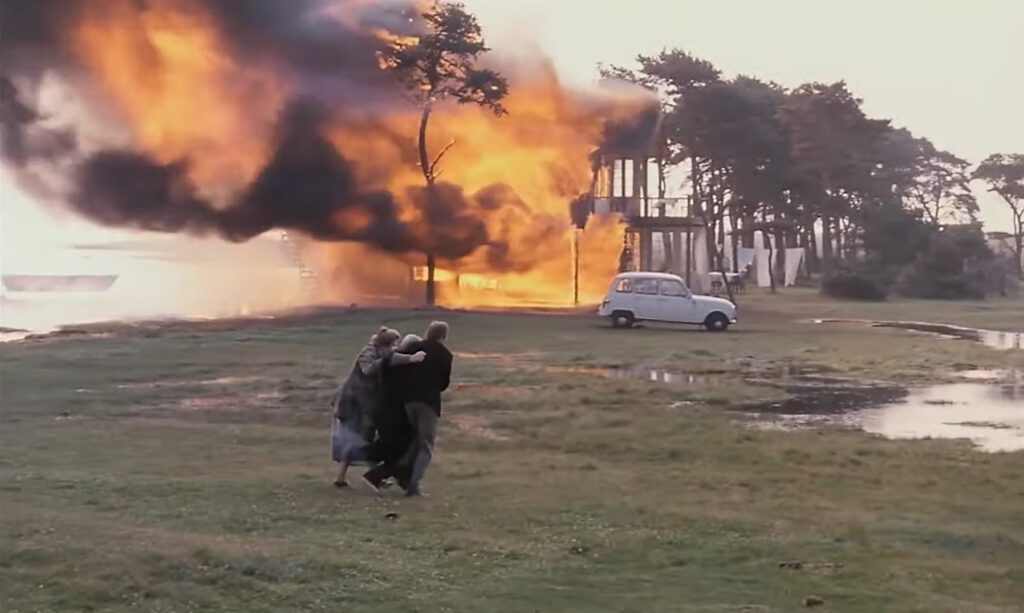
The reason for this inversion is already clear from Nostalghia. The image of “home” in Tarkovsky’s last five films, as well as in The Wizard of Oz, is synonymous with happiness, but as the sacristan tells Eugenia, “there are more important things.” Tarkovsky evidently wished to move beyond the problem of personal satisfaction in order to answer how we can live in a world that’s so far gone that it threatens to destroy all life.
Nostalghia had only partly answered that question. In the contrast between Domenico and Gorchakov in the final two scenes, it had shown how an individual might influence the world for the better, becoming the spark that saves the world. There is an element of sacrifice in the actions of both men, but on this subject the movie had left something unsaid. Domenico’s sacrifice is pompous and foolhardy, and it would be unlikely to influence anybody or improve the world. Gorchakov’s final gesture is made in the proper spirit, and it could potentially change the world, but the sacrificial part of it is largely accidental. The act is a gift to Domenico, and Gorchakov must travel out of his way, endure the embarrassment of filling the madman’s shoes, and persist in carrying the flame across a windy pool, but none of that makes quite the impact of his heart attack at the end.
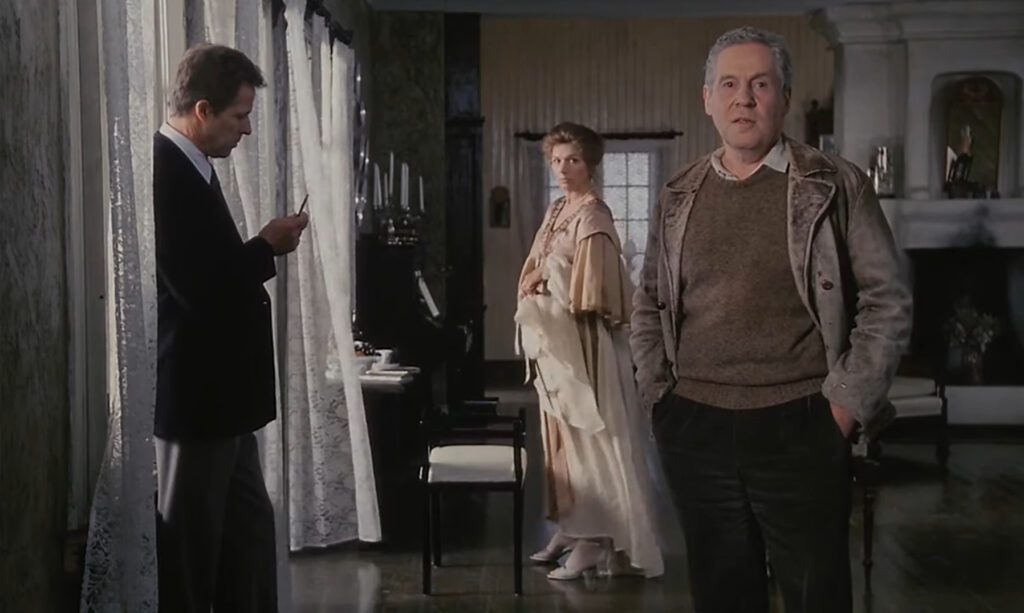
Unlike Domenico and Gorchakov, Alexander does not give up his life. In his prayer he promises, rather, “I will relinquish everything that binds me to life.” In other words, he will make of his entire remaining life a gift to God, to the world, and to the people he loves. The Sacrifice begins on Alexander’s birthday, giving it multiple occasions to equate the act of sacrifice with the giving of a gift. Alexander receives a book of icons and a bottle of wine from Victor, an antique map of Europe from Otto, and a miniature model of his house from Little Man (with Otto’s help). The film begins with a detail from Leonardo da Vinci’s unfinished painting The Adoration of the Magi showing the presentation of gifts to the Christ child. As Otto tells Alexander, “Every gift involves a sacrifice. If not, what kind of gift would it be?” This spirit of gift-giving, the movie tells us, will be needed if the world will be saved.
There’s still another part of the sacrificial act that the movie goes to great length to emphasize, and it’s contrary to the usual perception of gift-giving. When we first see the Leonardo painting – which appears repeatedly – it’s ambiguous who’s giving a gift. With his hunched back, grayish hair, hollow eyes, and supplicant position, the Magus looks like a beggar, and the infant’s hand touches the ciborium from a superior position as if the gift might just as well be passing from above to below. In the modern world at least, a gift is a token of largesse, putting the giver in a superior position. Even when Otto says that a gift must be a sacrifice, we might misunderstand him. It’s not only that an act of charity must cost the giver – rather, it only counts if the giver adopts a position of inferiority.
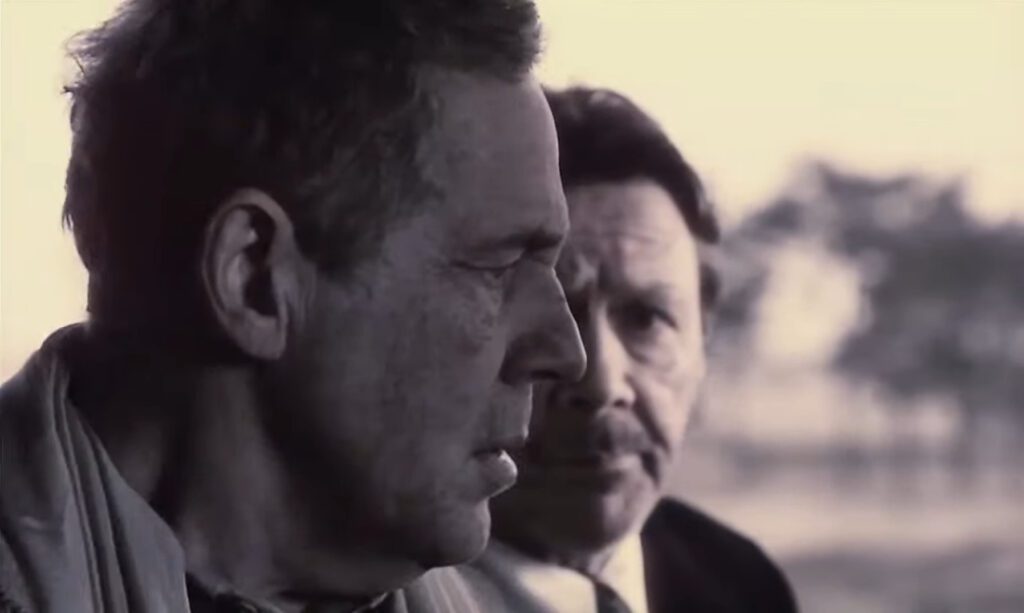
Ever since Andrei Rublev, Tarkovsky’s films have argued that worthwhile action must come from a low place. The bellcaster’s son slaves for months in a muddy pit; the Stalker enters the room face down against his will; and Gorchakov descends into a slimy pool, making a fool of himself, repeating a lunatic’s quest before the tourists at a Tuscan bath. Each of those acts is sacramental in its force, climaxing the film and resulting in a kind of elevation – the bell rises to the church and inspires Rublev; the Stalker’s daughter transcends her handicap; and Gorchakov ends in a kind of heaven. In Solaris too, gifts come from below, from the living ocean to the cosmonauts hovering above. The idea is consistent with Christ’s teaching in the Sermon on the Mount in the Gospel of Matthew (an excerpt from Bach’s St. Matthew Passion brackets the film), and the whole premise of Christianity is that Christ made a gift of his own life – that in the incarnation and crucifixion God lowered himself before his own creation to save the world.
As if to remind us what a sacrifice means, the film is filled with people and things falling down, characters sitting on the ground or the floor, collapsing, slumping, kneeling, crawling, lying down. Little Man jokingly pulls Otto’s bicycle down with a lasso; Otto falls on the floor touched by “an evil angel”; a jar of milk crashes down from a shelf; Alexander falls off his bicycle. Alexander and Little Man sit in the grass together; Alexander and Otto sit side by side on the floor; and when the house burns almost everyone takes turns falling to the ground, overcome with emotion. The house itself falls too. As the condition for his wish, Otto tells Alexander he must “lie” (ligga) with Maria, and doing so – like the other acts of abasement in Tarkovsky’s films – results in a symbolic or spiritual elevation, as their two bodies levitate above the bed. Anything holy or exalted, in Tarkovsky’s view, must first be earned in the depths below. The film itself ends with elevation, even as Little Man lies flat on the ground. The camera rises up the tree Alexander had planted in the opening, and an inscription dedicates the film to Tarkovsky’s son Andrei “with hope and confidence”.
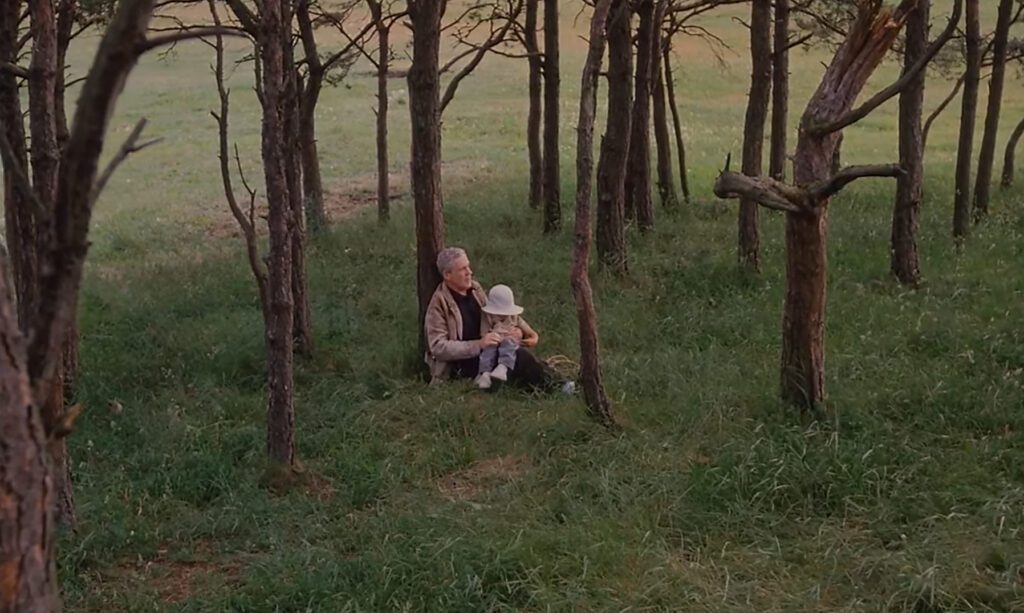
That dedication, and those last words especially, are not altogether separate from the film’s substance. The Christian virtues of faith (which is related to confidence), hope, and love map closely onto the triad of courage, brains, and heart personified in The Wizard of Oz. They also unite the three extraneous stories told in The Sacrifice:
- While planting the tree, Alexander tells his son of an orthodox monk who had his pupil water a barren tree every day, believing he could change the world through simple repetitive action.
- Otto tells a supernatural story of a woman in Königsberg whose son appeared beside her in a photograph twenty years after his death.
- Alexander tells Maria how he spruced up his dying mother’s garden, only to find that he had destroyed its beauty.
Each of these tales is a picture of incomplete virtue. The monk’s ritual is an act of faith motivated by hope, but it’s too habitual to exemplify love. Otto’s story abounds with love and hope, but his rigorous search for evidence lacks faith. Alexander’s labor in his mother’s garden was an act of love and faith, but it left him without hope. In contrast, Alexander’s sacrifice at the end is a consummate act of faith, hope, and love.
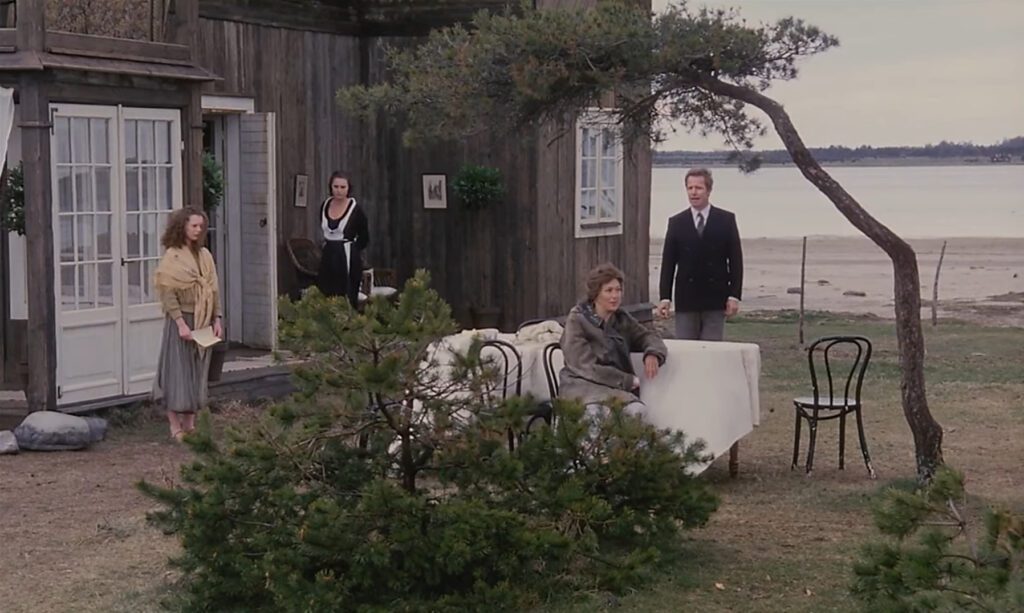
The point of The Sacrifice is to define the kind of action it will take to save the world from destruction. It’s not possible to prescribe a specific action – everyone’s capacity and circumstances are different – but the film hopes to define the essence of the required action, and each viewer can translate it into real lived action. It’s important that the key word is “action”. It’s not the earnest words of Alexander’s prayer that save the world, but the action expressed in his promise. In order to set the world back the way it had been the day before, he vows to give up his ties to his family, to destroy his home, and lastly to give up spoken words.
A contrast between words and action runs all the way through The Sacrifice. In the opening, Little Man has just undergone a throat operation and cannot talk. Alexander quotes the Gospel of John: “In the beginning was the Word,” but he soon grows annoyed with his own wordiness, quoting Hamlet: “Words, words, words!” When the war begins, Adelaide implores the men in the room to “do something” – i.e. to take action instead of talking. At the end, Little Man and his father have switched places; the boy can speak, but Alexander is mute, and Little Man questions the verse from the Gospel of John.
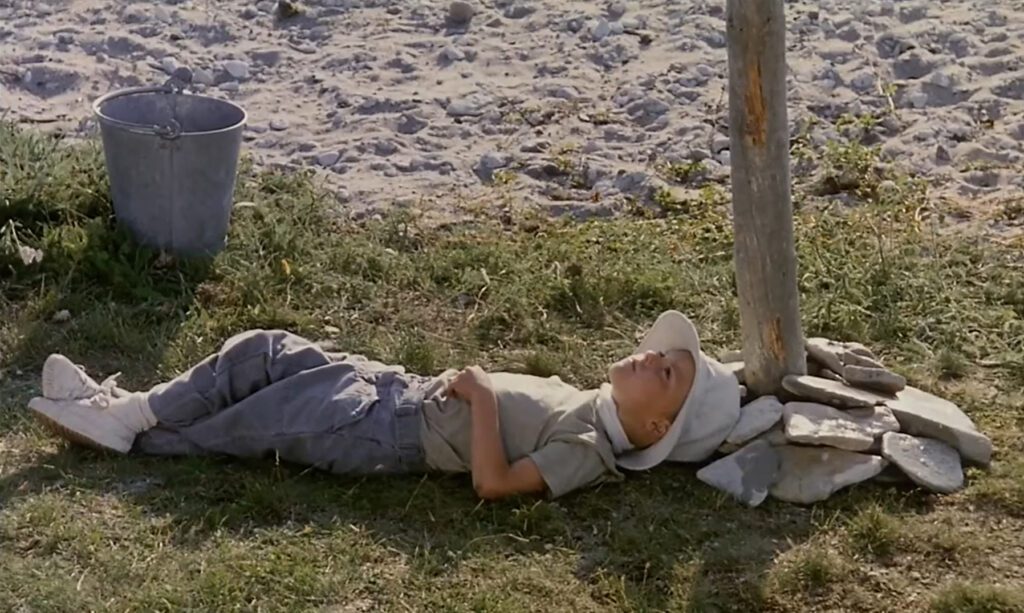
Tarkovsky was surely aware that film itself exists in an ambiguous zone between words and action. On one hand it’s a recorded expression, a potential incitement to action but almost like a form of speech. On the other hand his preferred analogy for cinema, “sculpting in time”, describes film as something carved out of real lived experience. Likewise, the viewer too must choose between watching passively (treating the film as a mere text) or participating actively, making a sacrament of the experience. In Stalker he places the viewer inside the Room for almost five minutes. In Nostalghia the viewer must be involved enough to walk across the pool with Gorchakov, carrying the candle with the same determination. In The Sacrifice, Alexander’s action will look like madness unless, during his prayer, we too feel the full horror of nuclear war and understand that his promise cannot be mere words.
CONNECTIONS:
The Wizard of Oz – Color scheme reversed in the middle; mission at witch’s home; witch on a bicycle; granting of a wish; three men lacking brains, heart, and courage; tornado/war; Toto/Otto; home as a synonym for happiness
Ordet – Reference to the first words of the Gospel of John
Conflagration – Protagonist sets fire to the place he loves most
Persona – Character who gave up acting when troubled by the boundary between stage and life; compositions setting two faces at right angles to each other
Andrei Rublev – Effective action comes from a low place
Zabriskie Point – Ends with the fiery destruction of a house; argument for action over words; words are the last item blown up (in Daria’s vision) or given up (in Alexander’s prayer)
Solaris – Metaphorical importance of character(s) falling down
Stalker – Sepia and color; Wizard of Oz allusions; vibrating glasses
Nostalghia – Final action appears insane unless the viewer is actively involved; necessity of saving the world; skepticism toward words
Breaking the Waves – Allusion to the opening verse of the Gospel of John; character instructed to sleep with someone other than the spouse; sacrifice at the end
LIST OF PROSTRATIONS & ABASEMENTS:
0:00:23 – Magus in Leonardo’s painting
0:06:13 – Little Man sits by the newly transplanted tree
0:12:08 – Otto sits on the ground
0:14:31 – Otto’s bicycle falls from under him, caught in the boy’s lasso
0:17:43 – Alexander sits in the grove with his son
0:22:05 – Little Man tackles his father and gets a nosebleed
0:22:22 – Alexander faints
0:22:30 – Car tipped on its side
0:24:08 – Painting of Christ entombed? (again in subsequent pages)
0:26:59 – Marta recalls Alexander dropping a vase during a play
0:31:30 – Otto’s bicycle falls when map is lifted
0:33:06 – Alexander sits on the floor in front of the map
0:42:59 – Otto collapses on the living room floor
0:45:56 – A jar of milk crashes on the floor
0:49:59 – Little Man lying in bed
0:57:31 – Adelaide collapses in Victor’s lap
0:57:56 – Marta kneels down to comfort Adelaide
0:59:05 – Victor slumps to the floor under Adelaide
1:00:31 – Julia kneels to give Adelaide an injection
1:01:35 – Adelaide is placed half-lying on the couch
1:02:39 – Victor kneels to give Marta an injection
1:08:20 – Victor kneels in front of Adelaide
1:13:24 – Alexander kneels down to pray
1:16:58 – Alexander crawls into his sofa
1:19:24 – Alexander bends down to touch the wet earth
1:26:46 – Otto sits on the floor in Alexander’s room
1:27:30 – Alexander sits on the floor next to Otto
1:35:58 – Julia is seen kneeling in the background
1:37:55 – Alexander falls off the bicycle
1:51:34 – Alexander kneels down over Maria’s bed
1:54:20 – Alexander and Maria lie down together
1:56:00 – Boy (Little Man?) lying down in a dream
1:56:05 – Alexander lying down in a dream
1:56:56 – Alexander sleeping on his couch
2:09:43 – Alexander loses balance and falls into a couch
2:14:11 – Alexander kneels to start the fire
2:16:57 – Alexander sitting on the ground watching the fire
2:17:51 – Alexander sits on the ground as the others run to him
2:17:56 – Victor kneels beside Alexander
2:18:08 – Alexander sits on the ground again
2:18:10 – Victor kneels beside Alexander again
2:18:17 – Adelaide sits on the ground embracing Alexander
2:18:24 – Marta falls to her knees
2:18:54 – Alexander kneels in front of Maria
2:19:33 – Julia comes into view kneeling behind Marta
2:19:52 – Alexander falls to the ground
2:20:29 – Alexander crawls on hands and knees into the ambulance
2:20:53 – Alexander crawls into the ambulance again
2:21:05 – Alexander sits in the ambulance for the last time
2:22:41 – Adelaide collapses on the wet ground
2:23:07 – The house falls down
2:26:07 – Cut to Little Man lying under the tree